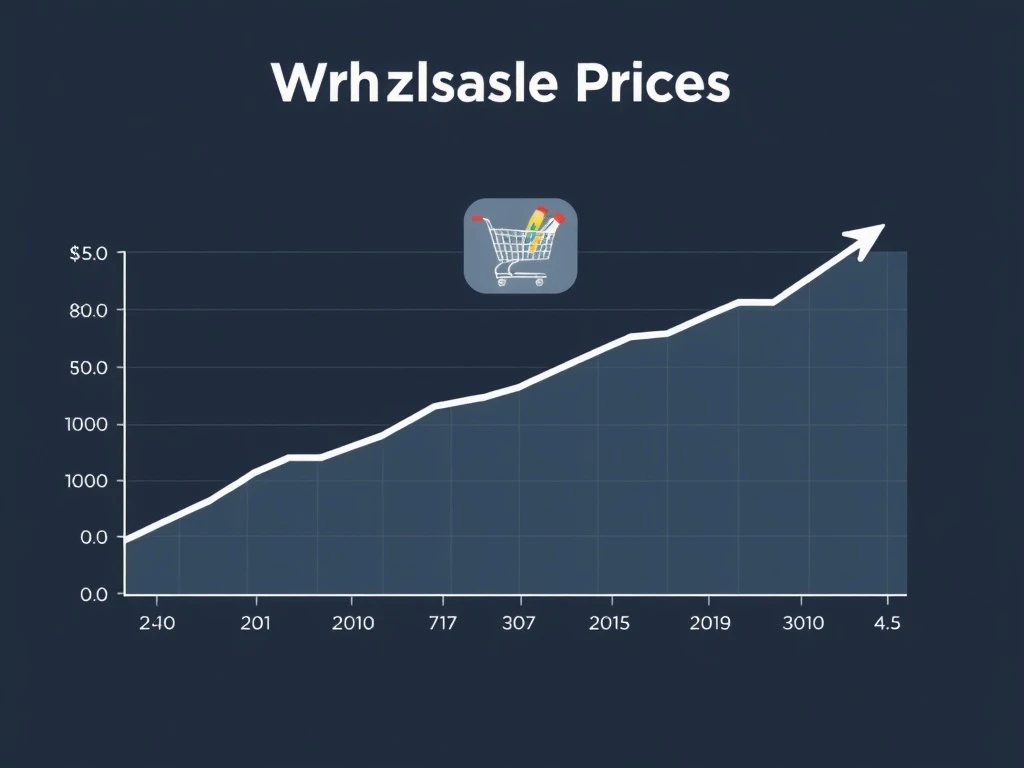The economic landscape often presents complex signals for businesses and consumers alike. Recently, a significant indicator emerged, capturing the attention of economists and market analysts. **Wholesale prices** have posted their largest surge in three years, according to the latest Producer Price Index (PPI) data. This notable increase raises immediate questions about the underlying causes and potential future implications. Specifically, many observers are now asking if this upward trend signals the onset of tariff-related inflation, which could impact everything from manufacturing costs to consumer spending power.
Understanding the Producer Price Index (PPI) and Wholesale Prices
To fully grasp the significance of this surge in **wholesale prices**, it is essential to understand the Producer Price Index. The PPI measures the average change over time in the selling prices received by domestic producers for their output. It essentially tracks prices from the perspective of the seller. Therefore, it provides an early indication of inflationary pressures. The index covers almost all goods-producing sectors and a significant portion of the services sector. Moreover, the PPI is often seen as a leading indicator of consumer inflation. When producers pay more for their inputs, they frequently pass those costs along to consumers.
Different components make up the PPI. These include:
- **Finished Goods:** Prices for products ready for sale to consumers.
- **Intermediate Goods:** Prices for products that require further processing.
- **Crude Goods:** Prices for raw materials.
This comprehensive scope makes the PPI a powerful tool for economic analysis. Furthermore, economists use it to forecast future inflation trends. Thus, a sharp rise in the PPI directly translates to higher **wholesale prices**, which ripple through the economy.
The Recent Unprecedented Surge in Wholesale Prices
The latest PPI report indeed highlighted a substantial increase in **wholesale prices**. Data shows the largest month-over-month increase in three years. This surge exceeded many economists’ expectations. Consequently, it triggered concerns about accelerating inflation. The specific sectors experiencing the most significant price hikes included energy, food, and various manufactured goods. For instance, energy prices saw a particularly sharp rise, driven by fluctuations in global oil markets. Additionally, agricultural commodities also contributed to the overall increase. Such broad-based increases suggest systemic pressures rather than isolated incidents.
Historically, a surge of this magnitude often precedes broader inflationary trends. The last time **wholesale prices** rose this quickly, the economy faced different challenges. Therefore, current conditions demand careful scrutiny. Analysts are now closely monitoring how these higher input costs affect various industries. Businesses, in turn, must decide whether to absorb these costs or pass them on. This decision significantly impacts profit margins and consumer affordability. Ultimately, the scale of this recent surge makes it a critical data point for policymakers and businesses alike.
Tariffs: A Potential Catalyst for Rising Wholesale Prices
One primary suspect behind the recent surge in **wholesale prices** is the impact of tariffs. Tariffs are taxes imposed on imported goods. When a country imposes tariffs, the cost of imported raw materials and components increases. Consequently, domestic manufacturers face higher input costs. This directly contributes to rising production expenses. Furthermore, these increased costs are then reflected in the **wholesale prices** of their finished products. The ripple effect can be substantial, impacting supply chains globally.
For example, tariffs on steel and aluminum imports can raise the cost of manufacturing everything from cars to appliances. Similarly, tariffs on electronic components affect technology companies. Businesses often absorb some of these costs initially. However, prolonged tariff impacts make this unsustainable. Eventually, they must adjust their pricing strategies. Therefore, the connection between tariffs and rising **wholesale prices** is a direct and logical one. The current geopolitical climate, marked by ongoing trade disputes, certainly amplifies these concerns. Many industries are already feeling the pinch of these added expenses, leading to difficult decisions about pricing and profitability.
Broader Inflationary Pressures Beyond Tariffs
While tariffs play a role, other significant factors also contribute to the current inflationary environment and the rise in **wholesale prices**. Supply chain disruptions, for instance, have been a persistent issue globally. The COVID-19 pandemic severely impacted global logistics, leading to shortages and delays. This created bottlenecks in production and distribution. Consequently, the limited availability of goods drives up their prices. Furthermore, strong consumer demand in certain sectors has also exerted upward pressure. As economies recover, consumers often have pent-up demand, which can outstrip supply. This imbalance naturally leads to higher prices across the board.
Energy costs represent another crucial factor. Fluctuations in global oil and gas prices directly affect transportation and manufacturing expenses. Higher fuel costs translate into more expensive shipping. This impacts every stage of the supply chain. Moreover, labor shortages in various industries have led to increased wage demands. Businesses often pass these higher labor costs onto consumers. Thus, the current surge in **wholesale prices** is likely a confluence of multiple economic forces. Understanding these interconnected factors is crucial for accurate economic forecasting. It also helps in formulating effective policy responses.
Impact on Businesses: Navigating Higher Wholesale Prices
The immediate impact of rising **wholesale prices** on businesses is profound. Manufacturers, for example, face increased costs for raw materials, components, and energy. This directly squeezes their profit margins. Businesses must then make critical decisions. They can absorb the higher costs, which reduces their profitability. Alternatively, they can pass these costs onto their customers. This strategy, however, risks alienating consumers or losing market share to competitors.
Retailers also feel the pressure. They purchase goods at higher **wholesale prices**. Consequently, their retail prices must also increase to maintain profitability. This can lead to decreased sales volumes if consumers become more price-sensitive. Small businesses, in particular, often lack the negotiating power of larger corporations. They may struggle more to absorb these rising expenses. Therefore, they are disproportionately affected. Many companies are exploring strategies to mitigate these impacts. These include optimizing supply chains, seeking alternative suppliers, or innovating to reduce production costs. Ultimately, the ability of businesses to adapt will determine their resilience in this inflationary climate.
The Ripple Effect on Consumers: From Wholesale to Retail
Ultimately, the surge in **wholesale prices** often trickles down to consumers. Producers and retailers eventually pass on their increased costs. This means consumers pay more for everyday goods and services. Higher prices for groceries, electronics, clothing, and even utilities become noticeable. This phenomenon is known as cost-push inflation. It erodes purchasing power and can significantly impact household budgets. Therefore, the latest PPI data directly affects the average household’s financial well-being.
For instance, if a clothing manufacturer pays more for fabric due to higher **wholesale prices**, the price of a shirt will likely increase. Similarly, higher fuel costs for transportation make every delivered product more expensive. This broader increase in consumer prices can lead to a decline in living standards if wages do not keep pace. Furthermore, it can prompt consumers to delay non-essential purchases. This shift in spending habits can then slow economic growth. Policymakers closely monitor this pass-through effect. Their goal is to prevent a wage-price spiral, where rising prices lead to demands for higher wages, which then fuel further price increases.
Government and Central Bank Responses to Inflationary Pressures
The rising **wholesale prices** and broader inflationary concerns place central banks and governments in a challenging position. Central banks, like the Federal Reserve, typically use monetary policy tools to manage inflation. Raising interest rates, for example, can cool down an overheating economy. This makes borrowing more expensive, which discourages spending and investment. Consequently, demand decreases, and price pressures ease. However, such measures also risk slowing economic growth or even triggering a recession. Therefore, central banks must carefully balance inflation control with economic stability.
Governments can also implement fiscal policies. These include adjusting taxes or government spending. For instance, subsidies for certain industries could help offset rising input costs. Conversely, reducing tariffs could directly lower import prices. However, these decisions often involve complex political considerations. The current debate around **wholesale prices** and inflation highlights the delicate tightrope policymakers must walk. Their actions will significantly influence the trajectory of the economy in the coming months. Furthermore, international cooperation on trade policies could also play a role in mitigating tariff-related inflation.
Economic Outlook and Future Projections for Wholesale Prices
Economists are currently analyzing the long-term implications of the surge in **wholesale prices**. Many anticipate that inflationary pressures may persist for some time. Supply chain issues, for example, could take longer to resolve than initially expected. Geopolitical tensions also add uncertainty to commodity markets. Therefore, businesses and consumers should prepare for potentially elevated prices in the near future. However, some economists believe that the current surge might be temporary. They argue that once supply chains normalize and demand stabilizes, prices could moderate. The debate centers on whether the current inflation is ‘transitory’ or ‘persistent’.
Key indicators to watch include future PPI reports, Consumer Price Index (CPI) data, and wage growth figures. These will provide further insights into the inflation trajectory. Investment decisions will also hinge on these forecasts. Sectors less reliant on imported goods or those with strong pricing power might fare better. Conversely, industries heavily dependent on volatile raw materials could face continued challenges. Ultimately, the path of **wholesale prices** will significantly shape the broader economic outlook. Market participants are closely watching for any signs of stabilization or further escalation. This will guide their strategic planning for the coming quarters.
Conclusion: Navigating the Surge in Wholesale Prices
The recent surge in **wholesale prices**, as indicated by the latest PPI report, marks a significant development in the economic landscape. This three-year high immediately prompts questions about the role of tariffs and other inflationary pressures. While tariffs undeniably contribute to higher input costs, broader factors like supply chain disruptions, strong demand, and energy price volatility also play crucial roles. This rise impacts businesses by squeezing profit margins and forcing difficult pricing decisions. Ultimately, these higher costs often trickle down to consumers, eroding purchasing power and affecting household budgets.
Policymakers, including central banks and governments, face the challenging task of managing these inflationary pressures without stifling economic growth. Their responses, whether through monetary policy adjustments or fiscal measures, will be critical. As the economy navigates this period of rising prices, businesses must adapt, and consumers must prepare for potential changes in affordability. Continuous monitoring of economic data, particularly the PPI, will be essential for understanding the evolving inflationary environment and its long-term implications for global markets.
Frequently Asked Questions (FAQs)
What is the Producer Price Index (PPI)?
The Producer Price Index (PPI) measures the average change over time in the selling prices received by domestic producers for their output. It tracks prices from the seller’s perspective, covering goods-producing sectors and many services. The PPI is a key economic indicator, often used to predict future consumer inflation.
How do tariffs affect wholesale prices?
Tariffs are taxes on imported goods. When tariffs are imposed on raw materials or components, they increase the cost for domestic manufacturers. These higher input costs are then passed on, leading to an increase in the wholesale prices of finished products. This directly contributes to inflationary pressures within the supply chain.
What other factors contribute to rising wholesale prices besides tariffs?
Beyond tariffs, several factors contribute to rising wholesale prices. These include global supply chain disruptions, which create shortages and delays; strong consumer demand, which can outstrip supply; and fluctuations in energy costs, which affect transportation and manufacturing expenses. Labor shortages and increased wage demands can also push prices higher.
How does an increase in wholesale prices impact consumers?
An increase in wholesale prices typically leads to higher retail prices for consumers. Businesses often pass on their increased costs for raw materials, production, and transportation. This means consumers pay more for everyday goods and services, which can reduce their purchasing power and impact household budgets.
What is the significance of wholesale prices surging to a three-year high?
A surge in wholesale prices to a three-year high signals significant inflationary pressures within the economy. It suggests that businesses are facing rapidly increasing input costs. This trend often precedes broader consumer inflation, indicating potential challenges for both corporate profitability and consumer affordability in the near future.
What actions might central banks take in response to rising wholesale prices?
Central banks, like the Federal Reserve, might respond to rising wholesale prices by adjusting monetary policy. This often involves raising interest rates to cool down the economy and curb inflation. Higher interest rates make borrowing more expensive, which can reduce spending and investment, thereby easing price pressures. However, such actions must be carefully balanced to avoid slowing economic growth too much.








